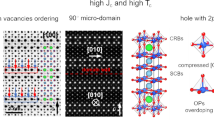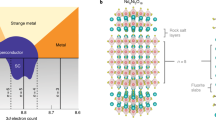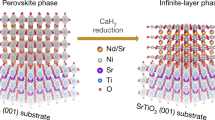Abstract
THE 'infinite-layer' compound1–3 AcuO2 (where A stands for cations such as strontium or calcium), has the simplest structure of all superconducting copper oxides, with only bare cations separating the CuO2 planes. Accordingly, an understanding of the doping mechanism(s) that lead to superconductivity in this compound may facilitate the elucidation of the same phenomenon in the other copper oxide superconductors. Recently, Azuma and co-workers2,4 observed planar defects in an infinite-layer phase synthesized at high oxygen pressure, and proposed that the defects are A-cation deficient, and lead to superconductivity (with transition temperature Tc≈ 100–110 K) in this compound. Here, based on quantitative X-ray and high-resolution electron-microscopic analysis of the planar defects in (Sr, Ca)CuO2, we propose that the defects consist of a corrugated Sr–O layer substituted for a CuO2 layer, with the incorporation of apical oxygen atoms (which are absent in the parent structure) at roughly half the available sites in the neighbouring Sr layers. This is equivalent to an insertion of a Sr3O2 ± x block in an otherwise infinite-layer sequence. The variable oxygen stoichiometry of our defect model can account for the occurrence of p-type superconductivity (following high-pressure oxygenation), n-type superconductivity (high-pressure reduction) or lack of superconductivity (high-pressure neutral-atmosphere annealing) in this system, depending on the synthesis conditions4.
This is a preview of subscription content, access via your institution
Access options
Subscribe to this journal
Receive 51 print issues and online access
$199.00 per year
only $3.90 per issue
Buy this article
- Purchase on Springer Link
- Instant access to full article PDF
Prices may be subject to local taxes which are calculated during checkout
Similar content being viewed by others
References
Siegrist, T., Zahurak, S. M., Murphy, D. W. & Roth, R. S. Nature 334, 231–232 (1988).
Azuma, M., Hiroi, Z., Takano, M., Bando, Y. & Takeda, Y. Nature 356, 775–776 (1992).
Jorgensen, J. D., Radaelli, P. G., Hinks, D. G. & Wagner, J. L. Phys. Rev. B47, 14654–14656 (1993).
Hiroi, Z., Azuma, M., Takano, M. & Takeda, Y. Physica C208, 286–196 (1993).
Adachi, S., Yamauchi, H., Tanaka, S. & Mori, N. Physica C208, 226–230 (1993).
Radaelli, P. G. & Jorgensen, J. D. Nature 364, 286–287 (1993).
Dravid, V. P., Zhang, H., Zhang, J. P. & Marks, L. D. Physica C192, 31–34 (1992).
Principles of Analytical Electron Microscopy (eds Joy, D. C., Romig, A. Jr & Goldstein, J. I.) Ch. 4 & 5 (Plenum, New York, 1986).
Adachi, S., Yamauchi, H., Tanaka, S. & Mori, N. Physica C212, 164–168 (1993).
Hiroi, Z., Azuma, M., Takano, M. & Takeda, Y. Nature 364, 315–317 (1993).
Shimakawa, Y. et al. Physica C. (in the press).
Author information
Authors and Affiliations
Rights and permissions
About this article
Cite this article
Zhang, H., Wang, Y., Zhang, H. et al. Identity of planar defects in the Infinite-layer' copper oxide superconductor. Nature 370, 352–354 (1994). https://doi.org/10.1038/370352a0
Received:
Accepted:
Issue Date:
DOI: https://doi.org/10.1038/370352a0
This article is cited by
-
Influence of apical oxygen on the extent of in-plane exchange interaction in cuprate superconductors
Nature Physics (2017)
-
Superconductivity in CaCuO2 as a result of field-effect doping
Nature (2001)
-
Application of scanning SQUID petrology to high-pressure materials science
Nature (1997)
-
Probable hole-doped superconductivity without apical oxygens in (Ca, Na)2CuO2CI2
Nature (1994)
Comments
By submitting a comment you agree to abide by our Terms and Community Guidelines. If you find something abusive or that does not comply with our terms or guidelines please flag it as inappropriate.



